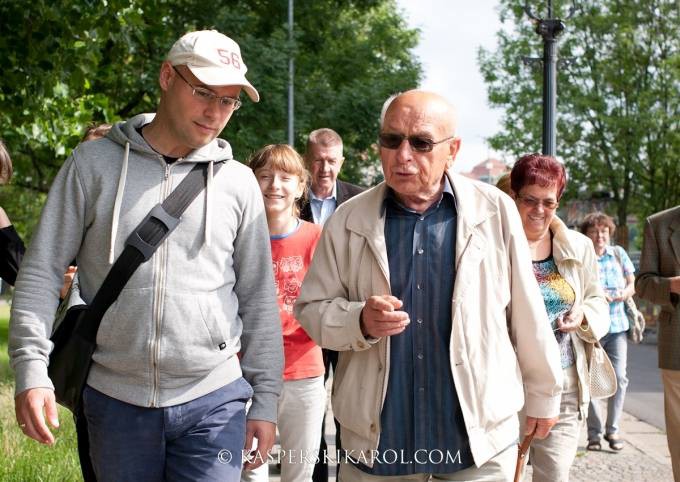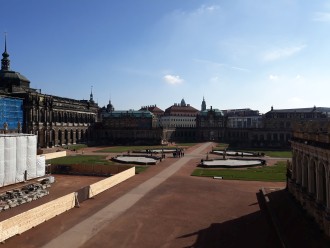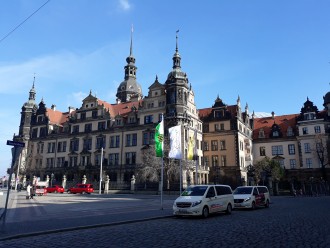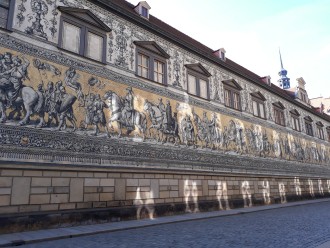City tours in Dresden | Day trips from Dresden

For decades Dresden and its picturesque surroundings attracts numerous tourists at any time of the year. While called Florence of the Elbe, Dresden is particularly impressive for its historic Old Town but also a lot of interesting objects in the area. At the same time, as the capital of the state of Saxony, it is of great importance as an administrative, industrial, scientific and commercial center.
Hi, my name is Witek and I have been living in Dresden since 2006, where for many years I have been guiding tourists, telling about the history of Dresden' historic buildings and the rich collections of paintings, porcelain and other valuables gathered there. As an art historian with the diploma of the largest university in the region - the Technical University of Dresden - I have the authority to show around the State Art Collections, including the Gallery of Old Masters at Zwinger, the Green Vault in the Residential Castle or as a licensed guide to the opera Semper. I am also a graduate of the musicology of the aforementioned university and organist of the Court Cathedral, where I try to impress my guests not only with the magnificent interior but also the unique Silbermann organs in this majestic temple. I also accompany groups visiting Saxon Switzerland and its historic castles - including the castle in Stolpen, the Königstein fortress, the Bastei rock formation in the Saxon Switzerland National Park, the cradle of the European porcelain Meissen and the castle Moritzburg.
Let the photos and short descriptions collected on this site be a foretaste of what I am trying to tell my guests with a pinch of humor. Naturally, with care to exhaust the subject without exhausting the listeners.

In the picture with Marian Sobkowiak, an exceptional man, a prisoner of German concentration camps, initiator of the collection for the reconstruction of the Frauenkirche church among his co-inhabitants of Gostyń, Poland. He died in February 2017.
----------------------------------------------------
Among the many historic buildings of the Dresden Old Town, some have been enjoying the unique interest of tourists for decades.
-
Zwinger
Undoubtedly, the most characteristic object in Dresden is Zwinger, a palace complex, which was built on the order of King August II Mocny as a place of court play. Here, the wedding of the successor of the Third Throne was celebrated by the successor of the throne. During the wedding, according to legends, wine flowed from the fountains in the courtyard and the courtyard was decorated with 60,000 lighted worlds. Today, Zwinger is more associated with the collections of paintings (Gallery of Old Masters), technical curiosities (the Mathematical and Physical Cabinet) and porcelain, available to connoisseurs with an inexpensive ticket.
-
Theater Square
A walk around the old town is worth starting from this place. In addition to the large historical significance of this one of the oldest squares in Dresden, it has a cultural landmark, but the square is surrounded by objects such as the Semper Opera, the Cathedral and Zwinger. The middle of the square is adorned with a statue of King Johann on a horse, from which he looks not at random in a certain direction. This ruler was honored in this way 16 years after his death.
-
Semper Opera
The former Court Theater is certainly the favorite place of Dresden's social cream, which takes 1,300 seats in a carefully rebuilt and finished hall with excellent acoustics and perfectly equipped stage design machinery, admiring the operas and operettas of the world's greatest classics of all ages. To its theatrical past, this building, which has been rebuilt twice, refers by a numerous sculptures of artists associated with the drama, integrated into the façade. As a licensed opera guide, I tour groups in English, German and Polish.
-
Royal Castle - Wettin's Residence
The castle was heavily damaged during carpet raids in February 1945. Although we have the impression of completing all stages of the reconstruction when watching it from the outside, this process is still going on, for example, in the large courtyard. A curiosity of the small courtyard is the glass dome covering it, which is a masterpiece of modern engineering. From this courtyard, tourists enter the breathtaking Green Vault, which is the former royal treasury.
-
Cathedral - Court Church
The magnificent edifice of the Roman Catholic church in the very heart of the Protestant city must arouse curiosity (although the Protestant majority is only 18% of the total population, compared to 4% Catholics). Equally peculiar, it may seem that the establishment of this temple, now the seat of the bishops, was decided by the politician - King August II Mocny converted to Catholicism to embrace the Polish throne. The cathedral has an excellent organ of Silberman, it is the largest instrument of this organmaster, whose completion he did not live to see, but his eldest son took care of it. Because the instrument has 47 voices and 3000 flutes, it is characterized by exceptional sound and acoustics. As an organist, since 2006 I have been sitting at the counter to play Silberman organ on some services. The picture below shows the view from the choir.
-
The prince's retinue
The world's largest painting on porcelain (of Meissen!) can be seen in one of the streets of Dresden's Old Town. It depicts rulers from the Wettin dynasty, people from the highest spheres of the city and even the author of this work. Fortunately, this painting survived carpet raids only with minor damage.
-
Brühl's terraces
This promenade, also known as the 'Balconies of Europe', is a great place for a short walk or a restful rest with views of the Elbe river and the hills of Radebeul on one side (where Karol May lived) and the rich Loschwitz district on the other. The ancient steam blades beneath the terraces below will take you to Saxon Switzerland or the city of porcelain - Meissen. Almost no one who walks on the terraces expects that European porcelain was born literally under their feet, in the walls of the fortifications of the former fortress of Dresden, on which the Brühl Terraces were created. -
The Frauenkirche church
This protestant church is undoubtedly the most important component of the Dresden panorama. Although, after decades of duration in the ruin, it was erected only as a replica of the former technically imperfect object, it attracts crowds of tourists, because it supports many recovered elements from rubble, which sometimes causes the building to be called colloquially the "largest puzzles in the world". This church is also the background of important cultural events, because it is exactly here, where various artists, choirs, and orchestras from around the world present their art.
Keywords: oprowadzanie po Dreznie, oprowadzanie po Dreźnie, wycieczka do Drezna, przewodnik po Dreźnie, zabytki Drezna, Striezelmarkt, jarmarki Drezno
Keywords: przewodnik Dresden, przewodnik po Zwingerze, przewodnik po Szwajcarii Saksońskiej, oprowadzanie po Zwingerze, oprowadzanie w Dreźnie, spacer po Dreźnie, Zwinger z przewodnikiem, przewodnik po Państwowych Zbiorach Sztuki w Dreźnie